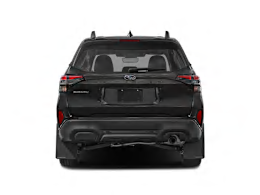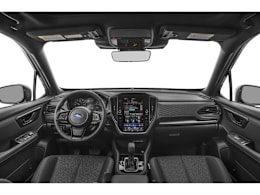The redesigned sixth-generation Forester continues with its core virtues of great outward visibility, a roomy cabin, a comfortable ride, excellent fuel economy, and standard all-wheel drive. Looking past the new styling with its chunky fender flares, beefier grille, and slick headlights, the most significant change is its noticeably quieter cabin—long a weak point for the Forester—thanks to the increased use of sound deadening. More than anything, the Forester remains true to its roots as a sturdy, functional, and practical small SUV. It should come as no surprise that it still ranks as one of the top-scoring models in the segment.
It’s disappointing that blind spot warning and rear cross traffic warning aren’t available on the Base trim, and are only optional—instead of standard—on the second-tier Premium. Both features are standard on higher trims above the Premium.
We bought a Subaru Forester Premium for $35,518—anonymously from an area dealer, as we do with every vehicle we test—for the purpose of this road test review.
Driving experience
The 180-horsepower, 2.5-liter “flat-four” engine (so-called due to the unique, horizontally-opposed cylinder layout) benefits from slightly more low-end torque than the outgoing model, which gives it some extra pep around town. But if you need to move with some real speed, the gas pedal has to be pressed down quite far, and at times the Forester feels underpowered. We appreciate that the continuously variable transmission (CVT) mimics the operation of a conventional automatic by simulating upshifts. While some CVTs tend to allow the engine revs to rise very high during even moderate acceleration, the Forester’s does a good job keeping revs at least somewhat low.
Acceleration isn’t impressive by any standard, although the 8.6 seconds the Forester needed to run from 0 to 60 mph is similar to many other small SUVs. Fuel economy is a commendable 29 mpg overall with the Forester’s standard all-wheel drive. A hybrid model will be offered in spring of 2025.
Similar to the powertrain, the Forester doesn’t feel sporty on a curvy road. It exhibits noticeable body roll if you pick up the pace, though it stays nice and secure. The steering is well-weighted and turns into corners naturally, and the Forester achieved an impressively high speed through our avoidance-maneuver test, thanks to its responsive nature. Braking performance was excellent with short stopping distances and a confidence-inspiring pedal feel.
The Forester continues to be the best-riding small SUV, outshining some luxury models. Its supple and absorbent suspension shrugs off all manner of bumps and soaks up potholes with ease. The new Forester is also considerably quieter than the previous model, with the most noticeable difference coming from its more muted engine hum.
Cabin comfort
The Forester’s cabin isn’t showy or full of fine materials; instead, it has a no-frills approach with little in the way of fancy trim or an abundance of padded areas. The leather wrap on the steering wheel feels kind of hard, and there are some pretty basic plastic panels throughout the cabin.
The front seats are comfortable and supportive, though the bottom cushion is a bit on the short side. The driving position is upright and elevated, giving a fairly commanding view of the road ahead; some taller testers felt that they were sitting too high, even after adjusting the seat to its lowest position. Headroom is plentiful, and we appreciate the center console’s slight cutout that frees up space for the driver’s right knee. Unlike many competitors, the Forester’s large windows, low belt line, and thin roof pillars all the way around afford great outward visibility which helps during everyday driving and urban maneuvering. Large and square-ish door openings make for easy access in and out of the vehicle.
The Forester’s rear seat is exceptionally roomy for a compact SUV, with good head- and knee room along with decent under-leg support. It’s annoying that Subaru continues to anchor the center rear seat belt in the roof, rather than integrating it into the seatback as with most small SUVs.
Cargo room is even larger than in the outgoing model, now up to a generous 38.5 cubic-feet, thanks to an unencumbered space and an expansive liftgate opening. That’s impressive, given the Forester’s modest footprint.
Controls and usability
As with most aspects of the Forester, the layout of its controls isn’t flashy but is largely user-friendly. We especially like that Subaru continues to include physical volume and tuning knobs. All Forester trims above the Base model come equipped with an 11.6-inch, portrait-oriented infotainment touchscreen. It’s simple, well-organized, and easy to use, but it can be slow to respond to inputs.
Most of the Forester’s climate controls are housed in the lower portion of the center screen, and as such the only truly easy aspects of the climate system are the large, physical temperature buttons for the driver and front passenger, along with front and rear defrost. At least other common functions, such as adjusting the fan speed or activating the seat heaters, remain visible on the screen. But we don’t like that you have to wade into the climate menu in order to change the airflow mode or switch to the “Auto” climate function.
Active safety & driver assistance
Standard active safety and driver assistance features include automatic emergency braking with pedestrian and cyclist detection, automatic emergency braking that operates at highway speeds, lane centering assistance, lane departure warning, lane keeping assistance, adaptive cruise control, and automatic high beams. Although Subaru’s well-known “EyeSight” suite of active safety and driver assistance features is standard on all Foresters, the Base model isn’t available with blind spot warning or rear cross traffic warning, both of which are optional (instead of standard) on the second-tier Premium trim. They do come standard on higher trims above the Premium.
A rear occupant alert system comes standard, which is designed to remind the driver—based on rear-door logic—to check the rear seat when they turn the Forester off to help prevent children and pets from suffering heatstroke or hypothermia if unintentionally left behind in the vehicle.


























